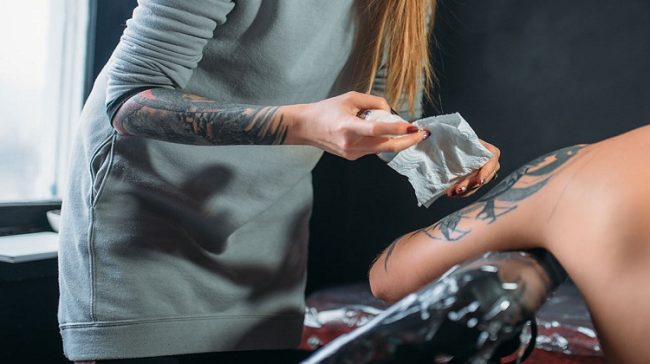
For many, getting a tattoo is a rite of passage and a way to express themselves through art. But with the pain of the tattoo gun comes anxiety and fear for some. That’s why tattoo numbing sprays have been introduced to make the process easier and less painful. In this guide, you will learn all about tattoo numb sprays, the benefits they provide, and what to look for when selecting the right one for you. With the right tattoo numb spray, you can enter the tattoo parlor with confidence, knowing that the entire process will be quick and relatively painless. So if you’re ready to take the plunge, let’s explore your options and get you ready for your new ink.
What To Look For When Selecting A Tattoo Numb Spray
The first thing you’ll want to look for when selecting a tattoo numbing spray is active ingredients. An active ingredient is the substance that induces the desired effect by reducing pain in the body. Most numbing tattoo sprays contain lidocaine or tetronic acid as the active ingredients. These ingredients are typically found in topical numbing medications and are great for reducing the pain of a tattoo. Another thing to look for is the concentration of the active ingredients. The higher the concentration, the more effective the numbness will be. The recommended concentration of lidocaine for topical numbing medication is between 5% and 7.5%. Some tattoo numb sprays are even stronger, offering 10% or more of lidocaine. When selecting a tattoo numb spray, you may also want to check the expiration date. Tattooing is generally a one-time use procedure, so you’ll want to select something that has a relatively short expiration date.
Ingredients To Avoid In Your Numbing Tattoo Spray
Although there are many great tattoo numb sprays on the market, there are a few ingredients to avoid. One to watch out for is benzocaine, which is not recommended for use on the skin. Benzocaine is often found in oral products and is commonly used for teething in children. While it can provide short-term pain relief, it’s not a good long-term solution. In fact, oral numbing products that contain benzocaine are generally not recommended for frequent use. Due to the fact that benzocaine is not easily metabolized by the skin, it can cause allergic reactions, skin irritation, and even ulcers in some cases. Another ingredient to avoid is tetracaine. While tetracaine is frequently used in oral numbing products, it is not recommended for use on the skin. Tetracaine is metabolized differently in the skin than in the mouth, which can cause serious side effects. This can result in allergic reactions and even death in some cases. While you may be tempted to save some money by purchasing a tattoo numb spray that uses one of these ingredients, it’s not worth the risk.
How To Apply The Numbing Tattoo Spray
Before you head to the parlor, make sure you’re prepared. Start by washing the area of the body you’re getting tattooed. This will not only help you avoid infection, but also make it easier for your artist to see the design. Next, you’ll want to apply a topical numbing cream or spray. Make sure to apply it in a thick layer on the skin where the tattoo will be. It’s best to wait until the last minute to apply the numb spray, as it needs to be in place for at least one hour to take effect. If you apply the spray beforehand, there is a chance that the tattoo artist may not be able to see the design as well.
How Long TheNumbSpray Will Last
As we’ve discussed, the amount of time the tattoo numb spray will last depends on the active ingredients used. For example, lidocaine is metabolized by the body every two to three hours. Because of this, you should plan to apply it again as needed if you have a long tattoo. How often you’ll need to reapply the spray depends on how quickly your body metabolizes it. As a general rule, if you feel like the numbing is wearing off, you can apply another dose. If the pain starts to return or you see signs of swelling, you should stop using the spray and seek medical attention.
Another thing that will affect how long the numb spray lasts is your natural pain threshold. People are different, so some may feel the effects of the spray faster than others. If you have a high pain tolerance, you may not benefit as much from the spray as someone who experiences more pain during the process.
Reasons Of Using A Tattoo Numb Spray
While traditional tattoos are becoming less common, they are still very much a part of modern culture. There are several reasons why someone would want to get inked, including aesthetic reasons and a desire to express themselves through art. If you’re considering getting a tattoo, it’s important to understand the pain involved in the process. A single session can last up to 10 hours depending on the size of the tattoo and the artist’s technique. The pain associated with the procedure can range from mild discomfort to extreme agony. While many people experience the tattoo process as a way to express themselves, others may experience it as something more like torture. If you fall into the latter category, you may want to look into getting a tattoo numb spray. A tattoo is a permanent mark on your body that you can show off to the world. There is no coming back from a tattoo once it’s there, so it’s important to make sure you are fully prepared for the pain it will cause.
Conclusion
There are a lot of reasons why people get tattoos, but there is one common denominator: pain. While many people are not bothered by the pain, others may be so uncomfortable that they need a tattoo numb spray to get through the process. There are plenty of options out there, so you’re sure to find one that suits your needs. When selecting a tattoo numb spray, make sure you select one with active ingredients that you can metabolize easily. From there, the only thing left to do is get your art and show it off to the world.




